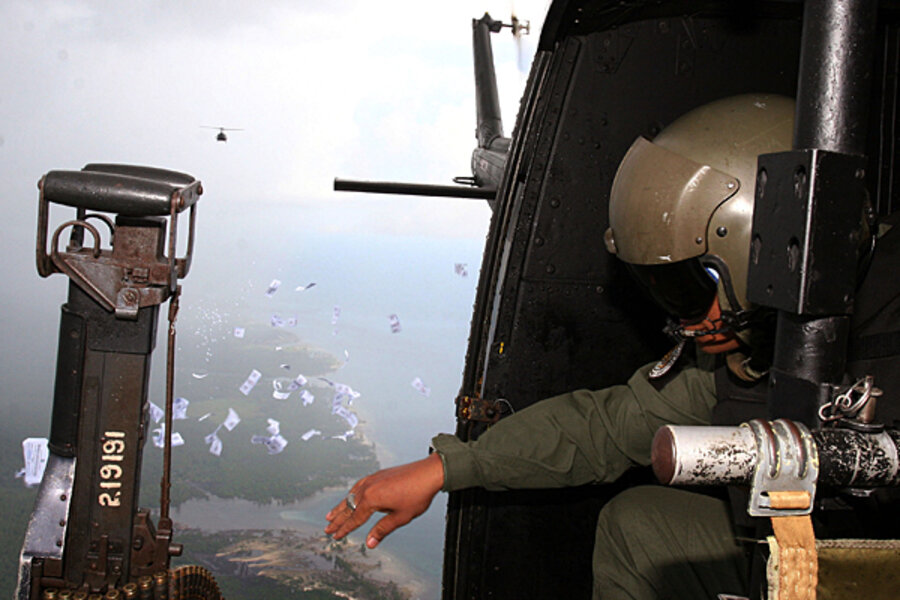US faces slog against Philippine militants, even with winning strategy
Loading...
| Zamboanga, Philippines
It began not long after 9/11, another front in an unfolding global war on terror. A deployment of US Special Forces arrived here to train, equip, and share intelligence with Philippines troops battling Islamic militants in a lawless crossroads of Southeast Asia.
Eight years on, US and Philippine commanders can point to successes: 15 of 24 high-value targets have been captured or killed. Militants are holed up in shrinking enclaves on a chain of far-flung islands. Terror attacks on major cities, once prevalent, have fallen off dramatically.
But the Joint Special Operations Task Force-Philippines (JSOTF-P), as the US mission of about 560 troops is called, also offers a lesson in how long it takes to uproot militant groups and the fragility of any gains in Mindanao, a violence-torn region that has seen many false dawns.
This fragility may keep US forces here for longer, trying to shepherd aid projects, plug holes in the underfunded Philippine military, and close down sanctuaries for terrorist groups with global aspirations, however atrophied by recent setbacks.
“Even though they’ve been reduced, until you can neutralize them and prevent these safe havens, the concern is that they will regenerate later on,” says Col. William Coultrup, the JSOTF-P commander, and a veteran of Special Forces operations in global hotspots.
Top targets still on the loose
Among the remaining targets are two bombmakers from Jemaah Islamiyah, the Indonesian group behind the 2002 Bali bombings and other atrocities. US commanders say the two men, Dulmatin and Umar Patek, are under the protection of Abu Sayyaf, a militant group that was formed on Jolo Island in the 1990s by ex-Afghanistan jihadists and later became known for audacious kidnappings.
Both men carry a generous US bounty on their head. Since 2001, the US has paid out $11 million here in reward money for tip-offs that net terror suspects, and the Philippines has given $2 million, according to the Philippine Army.
That nobody has turned in the two Indonesians points to the fearsome reputation of Abu Sayyaf, which has beheaded recent kidnap victims. It also underlines the limited reach of US and Philippine forces on Jolo, a rugged island of isolated valleys and dirt roads.
An added complication is the presence of jungle bases of other insurgents. Philippine officials accuse the rebels, which under a 1996 peace accord retains the right to its bases, of harboring Abu Sayyaf and hobbling their counterinsurgency operations.
For all this, Abu Sayyaf is fragmented and has fewer than 400 combatants, say Philippine officials. The US is providing aerial drones and other equipment that allows Philippine elite forces to mount increasingly sophisticated attacks on militant hideouts. But Abu Sayyaf attacks have continued.
That has raised suspicions that the Philippine military, which has benefited from generous US aid and prestigious official training, is dragging its feet on finishing the job, after coming close during a 2007-08 offensive, so that the aid keeps flowing.
Gen. Benjamin Dolorfino, commander of Philippine forces in Western Mindanao, insists that it’s just a matter of time before Abu Sayyaf leaders are captured or killed. “It’s like boxing. It will just require one lucky punch to get these leaders,” he says.
Deep pool of militant recruits
By itself, that won’t end the alienation on which militants have fed, he adds. Just as important, and fully endorsed by US commanders, is the need to extend government services to villages that have long festered in poverty and neglect. “It’s the task of nationbuilding,” says Dolorfino.
This task has spurred US troops to build schools, dig wells, and build roads, while helping the Philippine military to roll out its own projects. The location of projects is guided by intelligence reports on where militants are dug in, so that troops can move in and try to win over villagers in the area.
Many of the specialized US units deployed here are focused on development programs that can influence local populations and involve local authorities, whose buy-in is critical, say veterans of similar counterinsurgency programs in Afghanistan. They point out that senior Philippine military officers are also warming to the idea of development as a way to win a long-fought war.
The lack of local support is one reason why the fighting has dragged on so long, says Scott Harrison, director of PSA Asia, a security consultancy in Manila. “You can kill 50 people, but another 500 people will come in. There’s no shortage of people in Mindanao who want to pick up a gun and attack police and soldiers,” he says.
Another obstacle is the thinness of the 133,000-strong Philippine military, which is doing all the fighting (US troops are forbidden by law to engage in combat). Despite a multiyear modernization program and US assistance, Philippine commanders still lack airlift capacity and have few naval vessels to patrol a vast archipelago and porous sea borders.
Dolorfino says he has only two helicopters at his disposal. ‘What we need are transport helicopters so that we can ship forces rapidly from one place to another. We need to increase our mobility capabilities,” he says.





